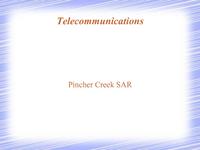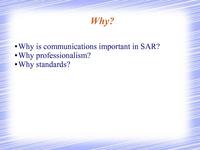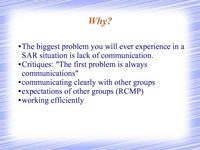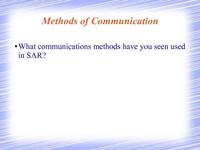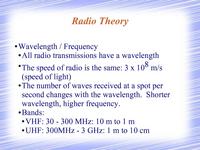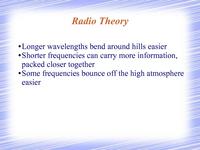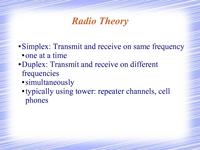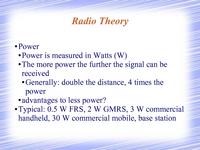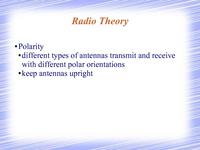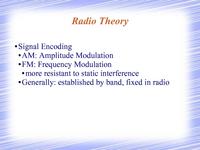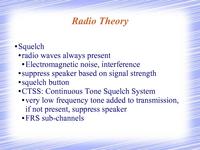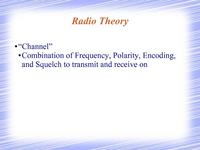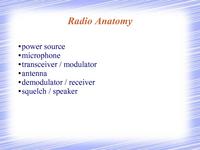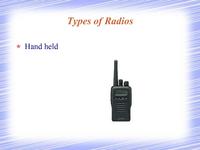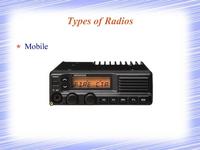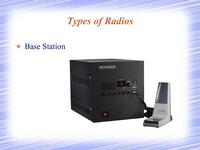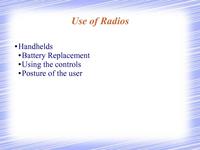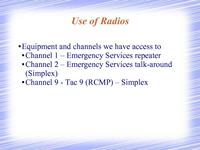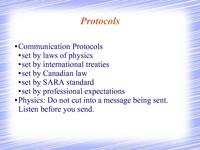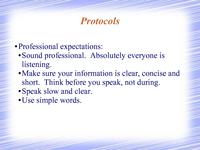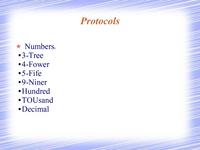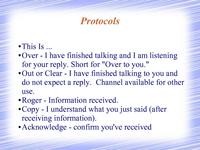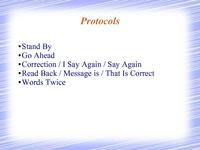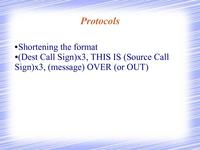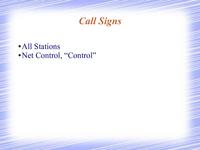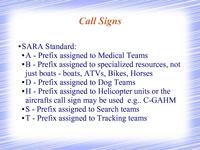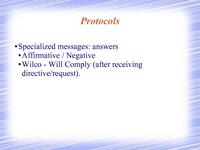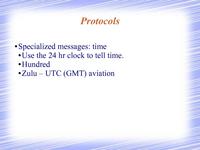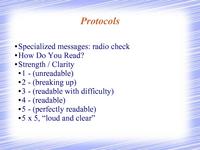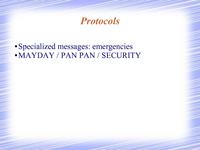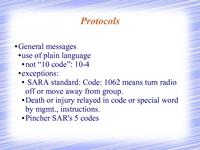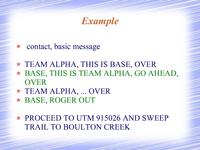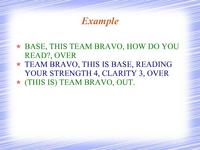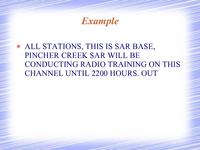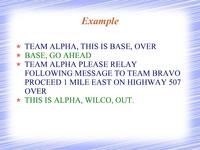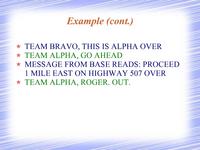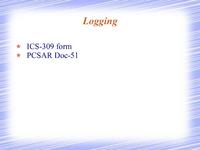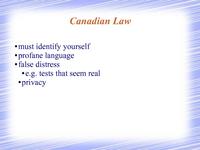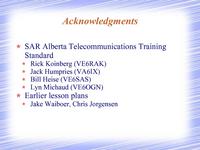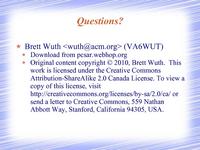SAR Fundamentals/Communications
From PCSAR
(→Aids) |
(→Time Plan) |
||
| (11 intermediate revisions not shown.) | |||
| Line 106: | Line 106: | ||
Communications is such an important aspect of SAR, so please review the following material: | Communications is such an important aspect of SAR, so please review the following material: | ||
| - | :□ Study Guide for Restricted Operator Certificate | + | :□ {{link|SAR Fundamentals/Communications/Study Guide for Restricted Operator Certificate}} |
:□ {{link|Members:Search and Rescue Fundamentals manual/Chapter 14|SAR Fundamentals Manual: Ch.14 (pg 201)}} | :□ {{link|Members:Search and Rescue Fundamentals manual/Chapter 14|SAR Fundamentals Manual: Ch.14 (pg 201)}} | ||
:□ {{link|Members:Basic Search and Rescue Skills textbook/Addendum 4|Basic SAR Skills Manual: Addendum 4 (pg F-9)}} | :□ {{link|Members:Basic Search and Rescue Skills textbook/Addendum 4|Basic SAR Skills Manual: Addendum 4 (pg F-9)}} | ||
| Line 122: | Line 122: | ||
== Time Plan == | == Time Plan == | ||
Total Time: 60 minutes | Total Time: 60 minutes | ||
| + | * 2018-12: 75 min -- Brett -- included too much theory | ||
* 2013-02: 52 min | * 2013-02: 52 min | ||
See {{nbw|2016|10|26}} | See {{nbw|2016|10|26}} | ||
| + | * {{link|Image:Members:2016-10-26 21 18 56u-scan.pdf}} | ||
| + | |||
{{lesson slides start}} | {{lesson slides start}} | ||
{{lesson slide|00:00|3 min}} | {{lesson slide|00:00|3 min}} | ||
| + | [[Image:Communications-Lesson-Slides.pdf|page=1|200px|right]] | ||
Introduce topic title | Introduce topic title | ||
| Line 133: | Line 137: | ||
Present Objectives | Present Objectives | ||
{{lesson slide|00:03|4 min}} | {{lesson slide|00:03|4 min}} | ||
| + | [[Image:Communications-Lesson-Slides.pdf|page=2|200px|right]] | ||
| + | [[Image:Communications-Lesson-Slides.pdf|page=3|200px|right]] | ||
* Why is communications important in SAR? | * Why is communications important in SAR? | ||
** The biggest problem you will ever experience in a SAR situation is lack of communication. | ** The biggest problem you will ever experience in a SAR situation is lack of communication. | ||
| Line 143: | Line 149: | ||
{{lesson slide|00:07|4 min}} | {{lesson slide|00:07|4 min}} | ||
| + | [[Image:Communications-Lesson-Slides.pdf|page=4|200px|right]] | ||
* What communications methods have you seen used in SAR? | * What communications methods have you seen used in SAR? | ||
** commercial radios | ** commercial radios | ||
| Line 150: | Line 157: | ||
** sat phone | ** sat phone | ||
** SPOT | ** SPOT | ||
| + | ** inReach | ||
** voice | ** voice | ||
** hand signals | ** hand signals | ||
| Line 156: | Line 164: | ||
{{lesson slide|00:11|3 min}} | {{lesson slide|00:11|3 min}} | ||
| + | [[Image:Communications-Lesson-Slides.pdf|page=5|200px|right]] | ||
* Basic Radio Theory | * Basic Radio Theory | ||
** all the wireless electronic communications methods are using radio waves | ** all the wireless electronic communications methods are using radio waves | ||
| Line 161: | Line 170: | ||
{{lesson slide|00:14|8 min}} | {{lesson slide|00:14|8 min}} | ||
| + | [[Image:Communications-Lesson-Slides.pdf|page=6|200px|right]] | ||
| + | [[Image:Communications-Lesson-Slides.pdf|page=7|200px|right]] | ||
| + | [[Image:Communications-Lesson-Slides.pdf|page=8|200px|right]] | ||
* Wavelength / Frequency | * Wavelength / Frequency | ||
** All radio transmissions have a wavelength | ** All radio transmissions have a wavelength | ||
| Line 178: | Line 190: | ||
{{lesson slide|00:22|3 min}} | {{lesson slide|00:22|3 min}} | ||
| + | [[Image:Communications-Lesson-Slides.pdf|page=9|200px|right]] | ||
* Power | * Power | ||
** Power is measured in Watts (W) | ** Power is measured in Watts (W) | ||
| Line 189: | Line 202: | ||
{{lesson slide|00:25|2 min}} | {{lesson slide|00:25|2 min}} | ||
| + | [[Image:Communications-Lesson-Slides.pdf|page=10|200px|right]] | ||
* Polarity | * Polarity | ||
** compare with polarized glasses | ** compare with polarized glasses | ||
| Line 195: | Line 209: | ||
{{lesson slide|00:27|3 min}} | {{lesson slide|00:27|3 min}} | ||
| + | [[Image:Communications-Lesson-Slides.pdf|page=11|200px|right]] | ||
* Signal Encoding | * Signal Encoding | ||
** AM: Amplitude Modulation | ** AM: Amplitude Modulation | ||
| Line 202: | Line 217: | ||
{{lesson slide|00:30|4 min}} | {{lesson slide|00:30|4 min}} | ||
| + | [[Image:Communications-Lesson-Slides.pdf|page=12|200px|right]] | ||
* Squelch | * Squelch | ||
** radio waves always present, but is it a real transmission? | ** radio waves always present, but is it a real transmission? | ||
| Line 214: | Line 230: | ||
{{lesson slide|00:34|1 min}} | {{lesson slide|00:34|1 min}} | ||
| - | + | [[Image:Communications-Lesson-Slides.pdf|page=13|200px|right]] | |
* "Channel" | * "Channel" | ||
** Combination of Frequency, Polarity, Encoding, and Squelch to transmit and receive on | ** Combination of Frequency, Polarity, Encoding, and Squelch to transmit and receive on | ||
| Line 220: | Line 236: | ||
{{lesson slide|00:35|1 min}} | {{lesson slide|00:35|1 min}} | ||
| + | [[Image:Communications-Lesson-Slides.pdf|page=14|200px|right]] | ||
* Anatomy of radio | * Anatomy of radio | ||
** power source | ** power source | ||
| Line 229: | Line 246: | ||
{{lesson slide|00:36|3 min}} | {{lesson slide|00:36|3 min}} | ||
| + | [[Image:Communications-Lesson-Slides.pdf|page=15|200px|right]] | ||
| + | [[Image:Communications-Lesson-Slides.pdf|page=16|200px|right]] | ||
| + | [[Image:Communications-Lesson-Slides.pdf|page=17|200px|right]] | ||
| + | [[Image:Communications-Lesson-Slides.pdf|page=18|200px|right]] | ||
* Types of radios | * Types of radios | ||
** ''show pictures'' | ** ''show pictures'' | ||
| Line 237: | Line 258: | ||
{{lesson slide|00:39|1 min}} | {{lesson slide|00:39|1 min}} | ||
| + | [[Image:Communications-Lesson-Slides.pdf|page=19|200px|right]] | ||
| + | [[Image:Communications-Lesson-Slides.pdf|page=20|200px|right]] | ||
| + | [[Image:Communications-Lesson-Slides.pdf|page=21|200px|right]] | ||
| + | [[Image:Communications-Lesson-Slides.pdf|page=22|200px|right]] | ||
| + | [[Image:Communications-Lesson-Slides.pdf|page=23|200px|right]] | ||
* Connectors & Mobile Antennas | * Connectors & Mobile Antennas | ||
** show pictures | ** show pictures | ||
{{lesson slide|00:40|8 min}} | {{lesson slide|00:40|8 min}} | ||
| + | [[Image:Communications-Lesson-Slides.pdf|page=24|200px|right]] | ||
| + | [[Image:Communications-Lesson-Slides.pdf|page=25|200px|right]] | ||
| + | [[Image:Communications-Lesson-Slides.pdf|page=26|200px|right]] | ||
* Use of radios | * Use of radios | ||
** Battery Replacement | ** Battery Replacement | ||
| Line 263: | Line 292: | ||
{{lesson slide|00:48|2 min}} | {{lesson slide|00:48|2 min}} | ||
| + | [[Image:Communications-Lesson-Slides.pdf|page=27|200px|right]] | ||
* Communication Protocols | * Communication Protocols | ||
** set by laws of physics | ** set by laws of physics | ||
| Line 272: | Line 302: | ||
{{lesson slide|00:50|1 min}} | {{lesson slide|00:50|1 min}} | ||
| + | [[Image:Communications-Lesson-Slides.pdf|page=28|200px|right]] | ||
* Professional expectations: | * Professional expectations: | ||
** Sound professional. Absolutely everyone is listening. | ** Sound professional. Absolutely everyone is listening. | ||
| Line 279: | Line 310: | ||
{{lesson slide|00:51|2 min}} | {{lesson slide|00:51|2 min}} | ||
| + | [[Image:Communications-Lesson-Slides.pdf|page=29|200px|right]] | ||
* Standard Words and Phrases | * Standard Words and Phrases | ||
* used internationally | * used internationally | ||
| Line 314: | Line 346: | ||
{{lesson slide|00:53|2 min}} | {{lesson slide|00:53|2 min}} | ||
| + | [[Image:Communications-Lesson-Slides.pdf|page=30|200px|right]] | ||
* Numbers | * Numbers | ||
** 3-Tree | ** 3-Tree | ||
| Line 324: | Line 357: | ||
{{lesson slide|00:55|12 min}} | {{lesson slide|00:55|12 min}} | ||
| + | [[Image:Communications-Lesson-Slides.pdf|page=31|200px|right]] | ||
| + | [[Image:Communications-Lesson-Slides.pdf|page=32|200px|right]] | ||
| + | [[Image:Communications-Lesson-Slides.pdf|page=33|200px|right]] | ||
| + | [[Image:Communications-Lesson-Slides.pdf|page=34|200px|right]] | ||
* Calling procedures | * Calling procedures | ||
** Treat like all your job is, is to pass on written messages. Think telegraph. | ** Treat like all your job is, is to pass on written messages. Think telegraph. | ||
| Line 342: | Line 379: | ||
{{lesson slide|01:07|6 min}} | {{lesson slide|01:07|6 min}} | ||
| + | [[Image:Communications-Lesson-Slides.pdf|page=35|200px|right]] | ||
| + | [[Image:Communications-Lesson-Slides.pdf|page=36|200px|right]] | ||
* Call Signs | * Call Signs | ||
* "All Stations" | * "All Stations" | ||
| Line 354: | Line 393: | ||
{{lesson slide|01:13|2 min}} | {{lesson slide|01:13|2 min}} | ||
| + | [[Image:Communications-Lesson-Slides.pdf|page=37|200px|right]] | ||
* Specialized messages: answers | * Specialized messages: answers | ||
** Affirmative / Negative | ** Affirmative / Negative | ||
| Line 359: | Line 399: | ||
{{lesson slide|01:15|2 min}} | {{lesson slide|01:15|2 min}} | ||
| + | [[Image:Communications-Lesson-Slides.pdf|page=38|200px|right]] | ||
* Specialized messages: time | * Specialized messages: time | ||
** Use the 24 hr clock to tell time. | ** Use the 24 hr clock to tell time. | ||
| Line 365: | Line 406: | ||
{{lesson slide|01:17|2 min}} | {{lesson slide|01:17|2 min}} | ||
| + | [[Image:Communications-Lesson-Slides.pdf|page=39|200px|right]] | ||
* Specialized messages: radio check | * Specialized messages: radio check | ||
* How Do You Read? | * How Do You Read? | ||
| Line 376: | Line 418: | ||
{{lesson slide|01:19|5 min}} | {{lesson slide|01:19|5 min}} | ||
| + | [[Image:Communications-Lesson-Slides.pdf|page=40|200px|right]] | ||
* Specialized messages: emergencies | * Specialized messages: emergencies | ||
** MAYDAY / PAN PAN / SECURITY | ** MAYDAY / PAN PAN / SECURITY | ||
{{lesson slide|01:24|8 min}} | {{lesson slide|01:24|8 min}} | ||
| + | [[Image:Communications-Lesson-Slides.pdf|page=41|200px|right]] | ||
| + | [[Image:Communications-Lesson-Slides.pdf|page=42|200px|right]] | ||
| + | [[Image:Communications-Lesson-Slides.pdf|page=43|200px|right]] | ||
| + | [[Image:Communications-Lesson-Slides.pdf|page=44|200px|right]] | ||
| + | [[Image:Communications-Lesson-Slides.pdf|page=45|200px|right]] | ||
| + | [[Image:Communications-Lesson-Slides.pdf|page=46|200px|right]] | ||
| + | [[Image:Communications-Lesson-Slides.pdf|page=47|200px|right]] | ||
* General messages | * General messages | ||
** use of plain language | ** use of plain language | ||
| Line 389: | Line 439: | ||
{{lesson slide|01:32|2 min}} | {{lesson slide|01:32|2 min}} | ||
| + | [[Image:Communications-Lesson-Slides.pdf|page=48|200px|right]] | ||
* Communications Traffic Logging | * Communications Traffic Logging | ||
** SARA Standard: log must be kept ICS-309 form | ** SARA Standard: log must be kept ICS-309 form | ||
| Line 394: | Line 445: | ||
{{lesson slide|01:34|3 min}} | {{lesson slide|01:34|3 min}} | ||
| + | [[Image:Communications-Lesson-Slides.pdf|page=49|200px|right]] | ||
* Canadian law | * Canadian law | ||
** must identify yourself | ** must identify yourself | ||
| Line 406: | Line 458: | ||
** Passing traffic | ** Passing traffic | ||
** Multiple Radio use simulation | ** Multiple Radio use simulation | ||
| + | {{lesson slide|01:36|}} | ||
| + | [[Image:Communications-Lesson-Slides.pdf|page=50|200px|right]] | ||
| + | [[Image:Communications-Lesson-Slides.pdf|page=51|200px|right]] | ||
| + | Questions | ||
{{lesson slides end}} | {{lesson slides end}} | ||
| Line 412: | Line 468: | ||
== Aids == | == Aids == | ||
{{prompt|What materials are needed or useful in presenting this lesson.}} | {{prompt|What materials are needed or useful in presenting this lesson.}} | ||
| - | + | * Slides {{document format links|Communications-Lesson-Slides}} | |
* FRS Radios | * FRS Radios | ||
* PCSAR's portable radios | * PCSAR's portable radios | ||
Current revision
Contents |
[edit] Subject
What is this lesson plan about?
This lesson plan covers the material of SAR Alberta's Telecommunications Training Standard.
[edit] Authors
List who wrote this lesson plan.
[edit] Scope
What is included in this lesson, what's not and why.
- SAR Fundamentals Manual: Ch.14 "Communications"
- Basic SAR Skills Manual: F-4 "Communications"
- Exercise
This training should include:
- Why communications is important
- Why professionalism, why standards?
- communications methods used in SAR
- Basic radio theory
- Radio waves / light waves
- Frequency
- Bands
- VHF: 30 - 300 MHz: 10 m to 1 m
- UHF: 300MHz - 3 GHz: 1 m to 10 cm
- Bands
- CTCSS - continuous tone coded squelch system
- interference
- FRS sub channels
- Propagation (sara std field)
- Anatomy of radios (sara std field)
- Types of radios
- Base (sara std field)
- Hand Held (sara std field)
- Mobile (sara std field)
- Repeater (sara std field)
- Simplex vs Duplex (Repeater)
- Connectors & Mobile Antennas (sara std field)
- Use of radios
- Battery Replacement (sara std field)
- Using the controls (sara std field)
- Posture of the user (sara std field)
- Base Radio setup and use (sara std control)
- Equipment and channels we have access to
- Communication Protocols
- Do not cut into a message being sent. Listen before you send.
- choosing your words
- Sound professional. Absolutely everyone is listening.
- Make sure your information is clear, concise and short. Think before you speak, not during.
- Speak slow and clear.
- Use simple words.
- Standard Words and Phrases
- ITU Alphabet (sara std field)
- numbers
- 3-Tree 4-Fower 9-Niner
- Calling procedures (sara std field)
- Over - I have finished talking and I am listening for your reply. Short for "Over to you."
- Out or Clear - I have finished talking to you and do not expect a reply.
- Roger - Information received.
- Copy - I understand what you just said (after receiving information).
- Acknowledge - confirm you've received
- This Is ...
- Go Ahead
- Stand By
- Correction / I Say Again / Say Again
- Read Back / That Is Correct
- Wilco - Will Comply (after receiving new directions).
- Affirmative / Negative / Wilco
- Use the 24 hr clock to tell time.
- Radio check
- How Do You Read?
- Strength / Clarity
- 1 - (unreadable)
- 2 - (breaking up)
- 3 - (readable with difficulty)
- 4 - (readable)
- 5 - (perfectly readable)
- MAYDAY / PAN PAN / SECURITY
- Use of plain language (sara std field)
- One exception 10-62 means turn radio off or move away from group. (sara std field)
- PCSAR's codes
- Death or injury relayed in code or special word by mgmt., instructions.
- Call Signs
- All Stations
- Communications Traffic Logging (sara std control)
- Laws
- must identify yourself
- profane language
- false distress
- e.g. tests that seem real
- privacy
- Hands On use of radios
- Calling other stations (sara std field)
- Passing traffic (sara std field)
- Multiple Radio use simulation (sara std control)
[edit] Prerequisites
What should students already know/have accomplished before the lesson is presented.
Communications is such an important aspect of SAR, so please review the following material:
- □ Study Guide for Restricted Operator Certificate
- □ SAR Fundamentals Manual: Ch.14 (pg 201)
- □ Basic SAR Skills Manual: Addendum 4 (pg F-9)
In particular:
- □ memorize the phonetic alphabet
- □ memorize the Procedural Words
- □ study the examples on how the Procedural Words are used
See Assigned reading
[edit] Objectives
At the conclusion of this lesson the participants:
- will meet the requirements of the SARA Telecommunications Training Standard
[edit] Time Plan
Total Time: 60 minutes
- 2018-12: 75 min -- Brett -- included too much theory
- 2013-02: 52 min
| Time | Material
|
|
00:00 3 min |
Introduce topic title Introduce Instructor Present Objectives |
|
00:03 4 min |
|
|
00:07 4 min |
|
|
00:11 3 min |
|
|
00:14 8 min |
|
|
00:22 3 min |
|
|
00:25 2 min |
|
|
00:27 3 min |
|
|
00:30 4 min |
|
|
00:34 1 min |
|
|
00:35 1 min |
|
|
00:36 3 min |
|
|
00:39 1 min |
|
|
00:40 8 min |
|
|
00:48 2 min |
|
|
00:50 1 min |
|
|
00:51 2 min |
|
|
00:53 2 min |
|
|
00:55 12 min |
|
|
01:07 6 min |
|
|
01:13 2 min |
|
|
01:15 2 min |
|
|
01:17 2 min |
|
|
01:19 5 min |
|
|
01:24 8 min |
|
|
01:32 2 min |
|
|
01:34 3 min |
|
|
01:36
|
|
|
01:36
|
Questions |
See Plan (odt) (pdf)
[edit] Aids
What materials are needed or useful in presenting this lesson.
- Slides (download/print: .pdf; edit: .odp)
- FRS Radios
- PCSAR's portable radios
- Brett's portable ham radio
- Example of PCSAR's mobile radio
- computer projector
- laptop
- computer presentation slides
- for each student:
- phonetic alphabet (handout or in text book)
- hand-out:
- see sar/pc/training/subject/sar-fundamentals/components/subject/11-communications
- Phonetic alphabet
- Examples
- Exercise
- Study Guide for Restricted Operator Certificate
- Chapter 14 outline Jorgensen/Waiboer
[edit] Question bank
List of questions suitable for an review/exam of this section.
see Question bank
[edit] Frequently Asked Questions
What are some of the questions that students typically ask. Include the answers.
Q: How do external cell phone boosters work?
A: See http://en.wikipedia.org/wiki/Cellular_repeater
[edit] Feedback
When has this lesson been presented. What was the feedback.
- 2010-10-06 Wuth presentation to PCSAR. Projector did not work. Ran out of time for exercise.
- see msg Date: Thu, 28 Oct 2010 13:32:17 -0600
[edit] License
What can others do with this lesson?
Original content copyright © 2010-2013, Brett Wuth.
This work is licensed under the Creative Commons Attribution-ShareAlike 2.0 Canada License. To view a copy of this license, visit http://creativecommons.org/licenses/by-sa/2.0/ca/ or send a letter to Creative Commons, 559 Nathan Abbott Way, Stanford, California 94305, USA.
[edit] Acknowledgements
- SAR Alberta Telecommunications Training Standard
- Rick Koinberg (VE6RAK)
- Jack Humpries (VA6IX)
- Bill Heise (VE6SAS)
- Lyn Michaud (VE6OGN)
- Earlier lesson plans
- Jake Waiboer, Chris Jorgensen
[edit] Reference Material
If you need to cite sources, do so here.
- SAR Fundamentals Manual: Ch.14 (pg 201)
- Basic SAR Skills Manual: Ch.F-4 (pg F-9)
- Study Guide for Restricted Operator Certificate
- The 2009 SAR Alberta Telecommunications Standard
- GMRS on Wikipedia
[edit] Notes
Any additional notes, etc.
